Written by: Castle Labs
Compiled by: Saoirse, Foresight News
Summary
For many, whether they can enter the realm of real-world assets (RWA) has become a benchmark for measuring whether cryptocurrencies have achieved mainstream adoption: only when we can connect the on-chain world with traditional finance can cryptocurrencies truly establish themselves as an attractive mainstream asset.
The once theoretical vision is gradually becoming a reality, with U.S. government bonds, bonds, and even real estate being tokenized and put on-chain.
Driven by the dual forces of regulatory clarity and technological maturity, RWA is gaining significant momentum.
This article focuses on the Arbitrum ecosystem, which is a Layer 2 solution that has successfully launched multiple projects focused on RWA, with the total locked value (TVL) of RWA assets exceeding $350 million.
This article will outline RWA on Arbitrum, the projects and initiatives driving its development, key assets and providers (including case studies), as well as relevant risk considerations and future prospects.
Overview of RWA on Arbitrum
The RWA market is thriving. Many early cryptocurrency adopters once envisioned a scenario where Wall Street elites would use cryptocurrencies. Today, that vision has been realized, with real-world assets finally successfully tokenized and beginning to be widely adopted.
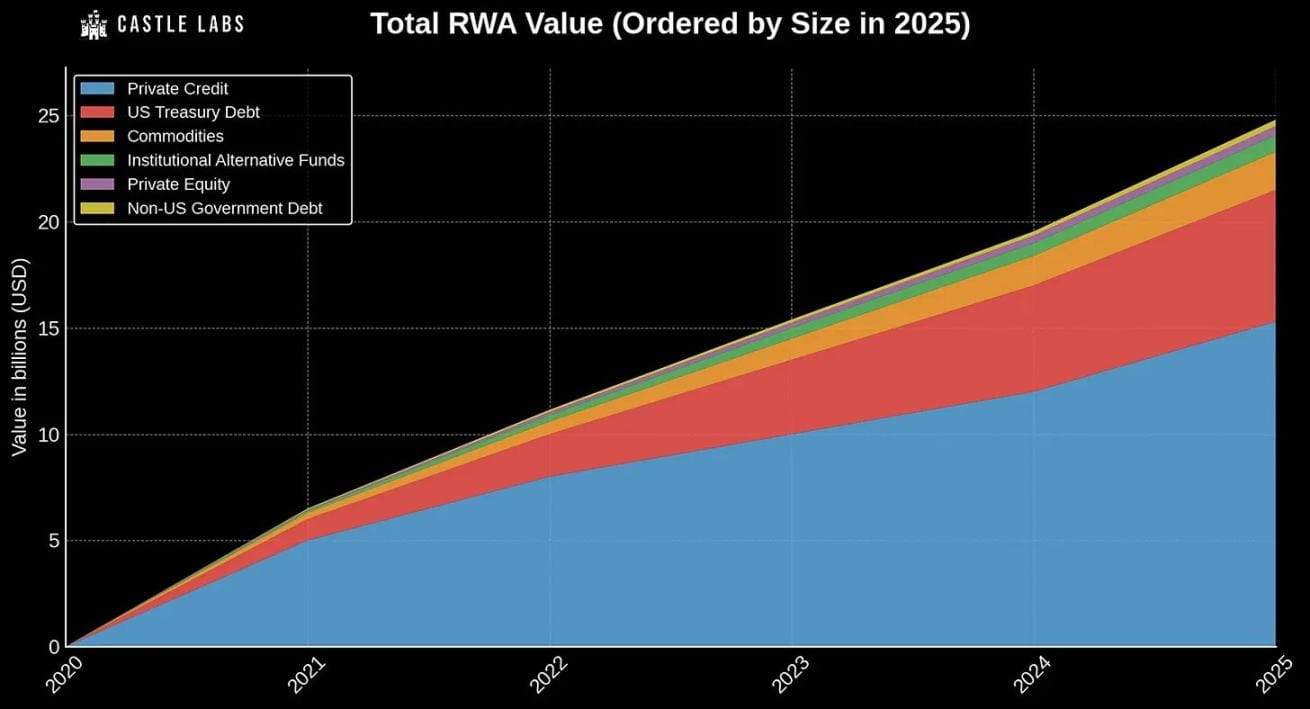
Source: rwa.xyz
Currently, the total value of RWA exceeds $25 billion, with the following specific distribution:
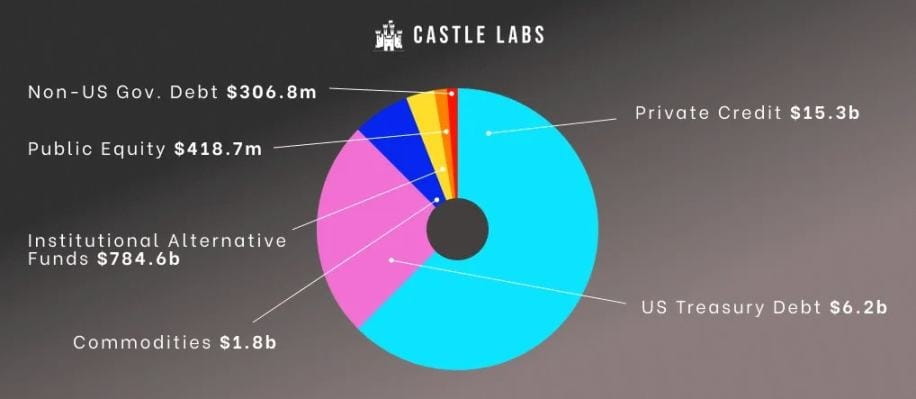
Source: rwa.xyz
Private credit: $15.3 billion (60%)
U.S. government bonds: $6.2 billion (26.9%)
Commodities: $1.8 billion (7.2%)
Institutional alternative funds: $784 million (3.26%)
Private equity: $418.7 million (1.71%)
Non-U.S. government bonds: $306 million (approximately 1.2%)
The tokenization of RWA is attributed to the interplay of various factors:
The regulatory framework for digital assets is maturing.
Technological infrastructure has reached production-grade reliability.
Institutional interest is rapidly heating up.
Cryptocurrencies are gradually being accepted and incorporated into regulatory frameworks, such as Europe's MiCA and the recently passed GENIUS Act in the U.S., indicating that these assets are gradually moving towards legalization in a broader financial environment.
Meanwhile, networks like Bitcoin and Ethereum have been operating stably for over a decade, fully demonstrating their security assurances, activity, and decentralization characteristics.
However, due to their inherent characteristics, RWA requires higher safeguards before achieving tokenization. Therefore, the emergence of L2 is highly attractive to institutional investors, as compared to the Ethereum mainnet, it can significantly reduce on-chain operational costs by several orders of magnitude.
Among many Layer 2 networks, Arbitrum is one of the fastest-growing solutions in the RWA field.
Why choose Arbitrum?
Mature and reliable technology stack
Credible on-chain neutrality
One of the leading capital pools in the cryptocurrency space
Arbitrum has a solid technology stack: its focus on technology-driven development, with the launch of technologies like Stylus and Timeboost, makes it an effective alternative to the Ethereum mainnet.
Additionally, Arbitrum's backend technology has been used as a cross-chain bridge for USDC by projects like Hyperliquidx, which extends beyond the functionality scope of its ecosystem. This fully demonstrates the credible neutrality of Arbitrum as a blockchain space. Credible neutrality refers to the principle that blockchain networks operate fairly, treating all participants equally without favoring any user, application, or outcome.
The significance of credible neutrality:
Trust: Users and institutions are more willing to rely on a platform that does not arbitrarily change the rules or favor one party.
Security: A neutral system is more resistant to manipulation or centralization risks.
Composability: DeFi can thrive only when developers are confident that no protocol will receive special treatment.
Institutional confidence: For RWA, neutrality ensures that tokenized assets do not face hidden risks (such as censorship or biased governance).
Finally, it is worth mentioning that Arbitrum has the sixth largest capital pool in the field, with assets exceeding $1.17 billion, and also has one of the most mature stablecoin ecosystems.
RWA can represent tangible assets and income-generating instruments while benefiting from the programmability and transparency of blockchain systems, bringing new opportunities for diversified investments, stable income, and improved capital efficiency for institutional investors and decentralized autonomous organizations (DAOs).
What proposals have driven this development?
This section briefly reviews the development history of RWA within Arbitrum. The initial development of RWA in Arbitrum was jointly promoted by the foundation and Arbitrum DAO.
Arbitrum DAO's first foray into RWA began with the Stable Treasury Endowment Proposal (STEP), followed by the RWA Innovation Grant Program, treasury management proposals, and finally STEP 2.
STEP (April 2024)
This proposal plans to invest over $85 million (35 million ARB) into real-world assets such as tokenized U.S. government bonds through institutional issuers.
Although the program was initially just a pilot project, after in-depth analysis of applicants, several providers were successfully selected:
Securitize's BUIDL
Ondo Finance's USDY
Superstate's USTB
Mountain Protocol's USDM
OpenEden's TBill
Backed's bIB01
The criteria for screening applicants are as follows:
No investment restrictions
A company with a clear organizational structure and no departmental fragmentation
Significant asset management scale, with multiple international securities identification codes (ISIN) exposure, and a well-experienced team.
Using public or decentralized tools and networks (rather than relying solely on proprietary tools and networks)
Avoiding companies with additional layers of decentralized governance
Having sufficient and detailed documentation
Furthermore, to ensure coverage is not limited to the aforementioned list, STEP also plans to invest 1% of the DAO treasury into tokenized real-world assets annually over the next five years. This plan also provides practical opportunities to gain deeper insights into the RWA field and balance ecosystem development with principal protection. Future iterations are expected to focus on one of these goals.
The STEP program has achieved tremendous success, bringing $600,000 in interest income to the Arbitrum DAO in less than a year.
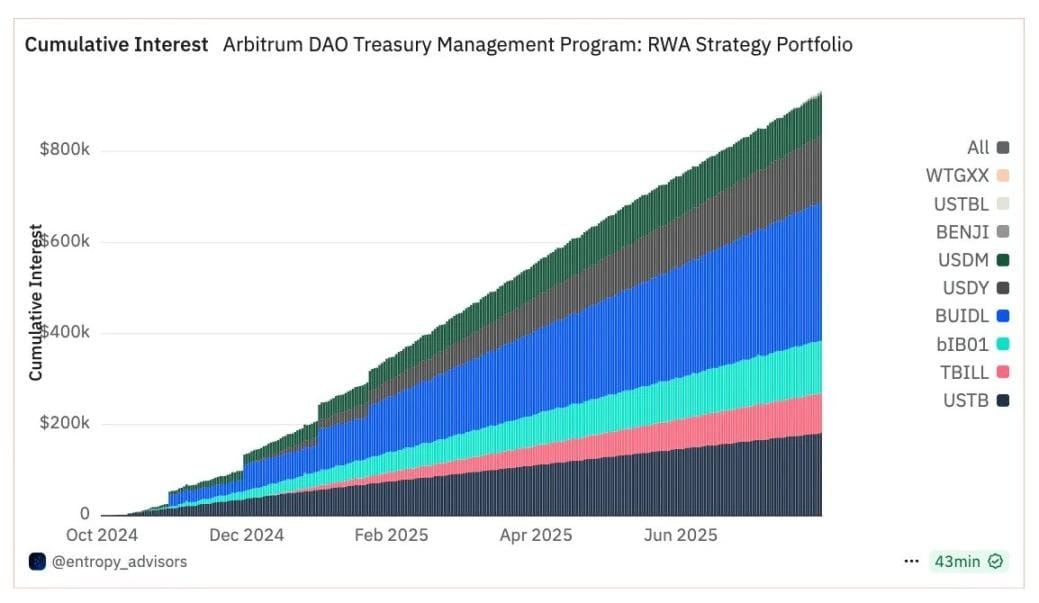
The following is the cumulative amount calculated monthly:
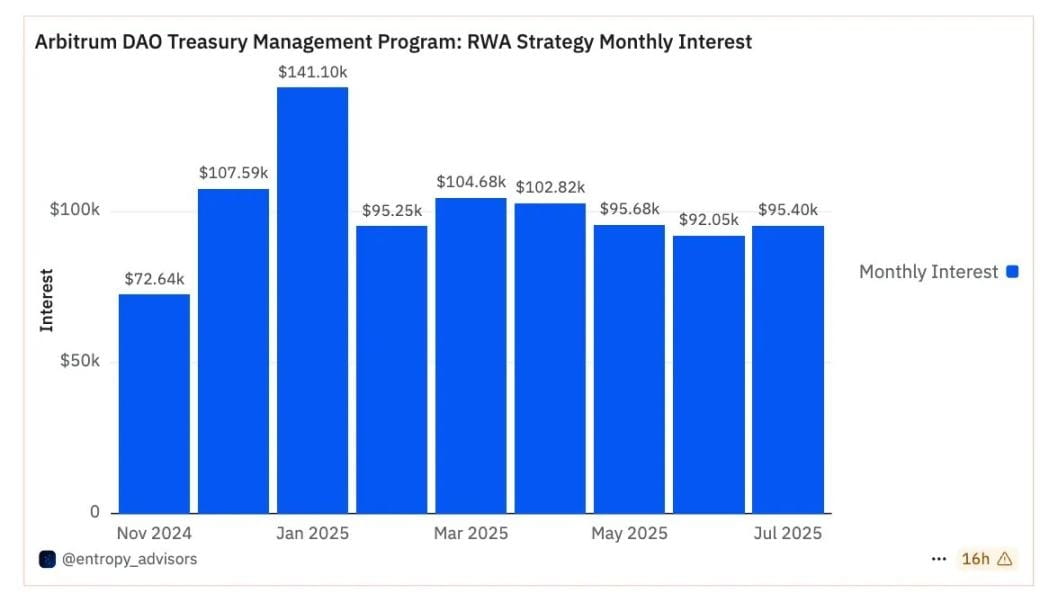
What sets STEP apart is its adherence to clear principles when collaborating with institutional service providers:
Direct evaluation and screening of income-generating stable assets without intermediary involvement.
Adopting a request for proposal (RFP) model, allowing protocol parties to submit product applications for review.
Institutional participants directly apply in decentralized forums, aiming to create sustainable income for the DAO.
RWAIG Grant Program (June 2024)
The Arbitrum Foundation funded a series of innovative grant projects (RWAIG), a two-month pilot program running from June to August 2024, aimed at supporting RWA integration, analysis, and research work within Arbitrum, with a budget of 300,000 ARB.
The primary goals of these grant projects are:
Significantly increase the activity of RWA within Arbitrum, gaining a leading position in competition, ensuring 'future growth security' for the platform.
Exploring how to allocate DAO treasury funds into RWA and how to launch on-chain tokenization on Arbitrum.
More widely integrating RWA assets and tools into existing ecosystem applications like GMX, Aave, and Pendle.
The program ultimately funded 8 different projects:
RWA Research: Educating users about the knowledge in this field
PYOR: RWA Analytics Dashboard
Mystic Finance: A lending market allowing users to borrow stablecoins against RWA assets as collateral
Jia: Transforming SMEs' receivables into tokenized assets
Truflation: Providing real-time inflation data
Backed Finance: Creating structured products tracking securities
Infinfty: Developing ERC-6651 RWA tokens to track the entire lifecycle of product procurement, performance, ownership, and environmental impact
Treasury management (December 2024)
By the end of 2024, a treasury management proposal will emerge to supplement the preliminary work of STEP. This proposal focuses on generating passive income by utilizing on-chain strategies with ARB tokens, rather than leaving the tokens idle in the treasury.
Its goals include:
Asset management: Managing 25 million ARB tokens, generating on-chain income.
Stablecoin exchange: Simplifying the process of exchanging ARB assets for stablecoins, minimizing slippage and market impact.
Stablecoin liquidity deployment: Converting 15 million ARB into stablecoins, invested into low-risk earning strategies to cover DAO expenses or service provider fees.
Diversification and stability: Focused on risk-adjusted returns while ensuring fund safety.
This strategy is divided into two directions:
Treasury: Reserving 10 million ARB for pure ARB strategies, converting 15 million ARB into stablecoins as the DAO's 'current account'
Growth: Allocating 7,500 ETH to decentralized finance (DeFi)
STEP 2 (January 2025)
Inspired by the preliminary success of STEP, the STEP 2 proposal was approved, adding an additional 35 million ARB (approximately $15.7 million).
After carefully reviewing over 50 applications, the STEP committee decided to allocate assets in the following proportions:
WisdomTree WTGXX: 30%
Spiko USTBL: 35%
Franklin Templeton FOBXX (BENJI): 35%
The importance of this plan is also reflected in the DAO's recognition of it.
STEP 2 was approved by an absolute majority, with nearly 89% of participants expressing support, 11% abstaining, and only 0.01% opposing.
These projects and initiatives collectively drive the development of real-world assets on Arbitrum, causing its total locked value (TVL) to grow from nearly zero to over $70 million in less than a year.
So what is the current situation?
What does the RWA landscape on Arbitrum look like?
The next section will leverage on-chain data to delve into the RWA assets, asset providers, and growth situation on Arbitrum.
Growth of RWA on Arbitrum
With a low-cost, high-throughput architecture and credible neutrality, Arbitrum is rapidly building an ecosystem composed of issuers, infrastructure providers, and incentive programs, significantly pushing RWA onto the blockchain.
Although Arbitrum initially focused primarily on DeFi foundational components, DEX, lending protocols, and yield aggregators, the early experiments of tokenizing U.S. government bonds on Ethereum in 2022 have drawn attention to the idea of bringing off-chain assets on-chain.
Currently, Arbitrum's RWA market capitalization is close to $350 million, with over 129 assets being tokenized. Although this number is remarkable, it only accounts for about 1.39% of the total market value of RWA assets, indicating strong growth potential for the future.
Despite significant variations in predictions, several forecasts have estimated the growth of on-chain RWA as follows:
Reach $16 trillion by 2030 (10% of global GDP)
Reach $30 trillion by 2034
In the first forecast scenario, the field is expected to grow 40 times over the next five years.
Arbitrum, as one of the most mature on-chain RWA networks, will gain significant competitive advantages.
The growth trajectory of RWA on Arbitrum
In just 2024, the total locked value (TVL) of Arbitrum grew from nearly zero to nearly $85 million by the end of the year.
This growth trajectory can be divided into three phases, closely related to the aforementioned key initiatives:
Early growth phase (Q1 2024): The total locked value of RWA on Arbitrum skyrocketed from nearly zero to over $5 million, showing initial development momentum.
Significant growth phase (Q2 2024): In the first half of 2024, the total locked value grew from about $20 million to about $70 million, coinciding with the funding allocation timeframe of STEP 1.
Continuous expansion phase: With increased DAO treasury allocations (STEP 2) and the addition of new RWA issuers (such as Spiko, WisdomTree, BlackRock), 2025 will maintain sustained growth.
This development is also reflected in the types of assets supported on-chain. In 2024, most RWAs were still U.S. government bonds. Over time, the types of assets continued to diversify, incorporating new varieties.
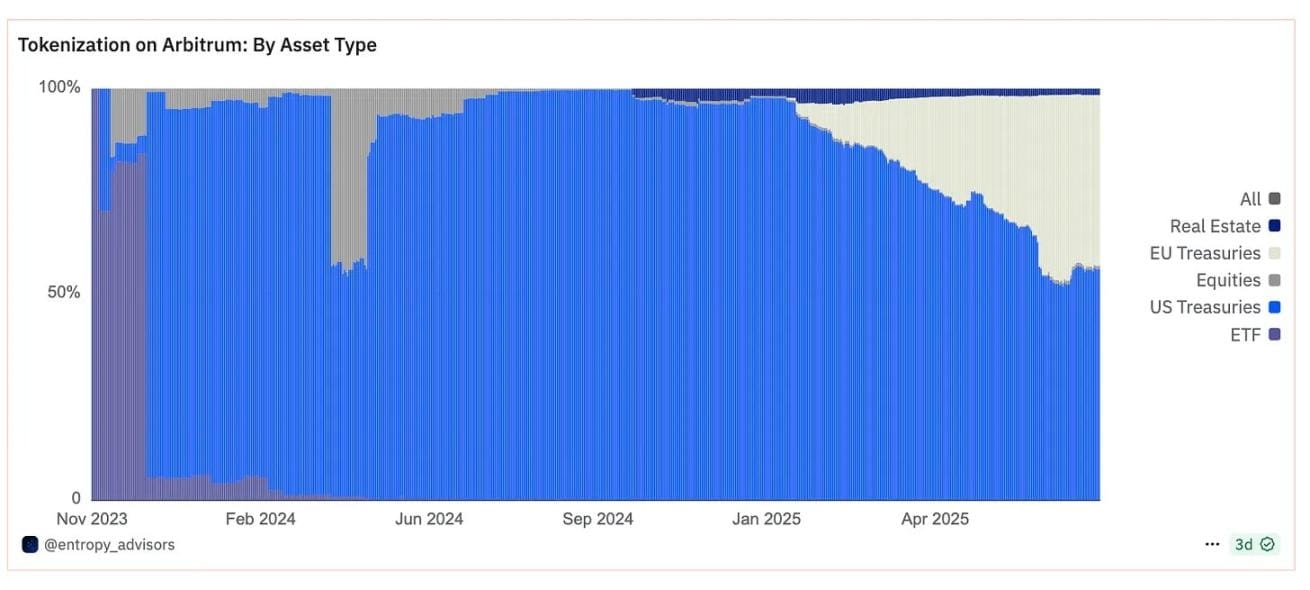
Although U.S. government bonds still account for the majority of asset types ($197 million), EU government bonds follow closely ($150 million). Alternative assets such as real estate, stocks, and ETFs are also gradually gaining attention.
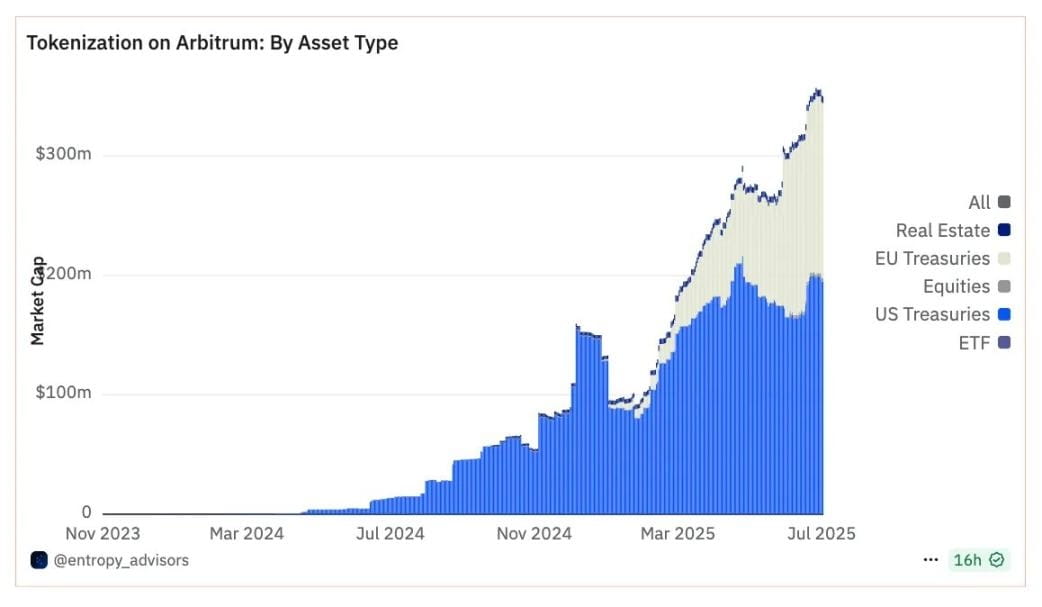
RWA assets and providers
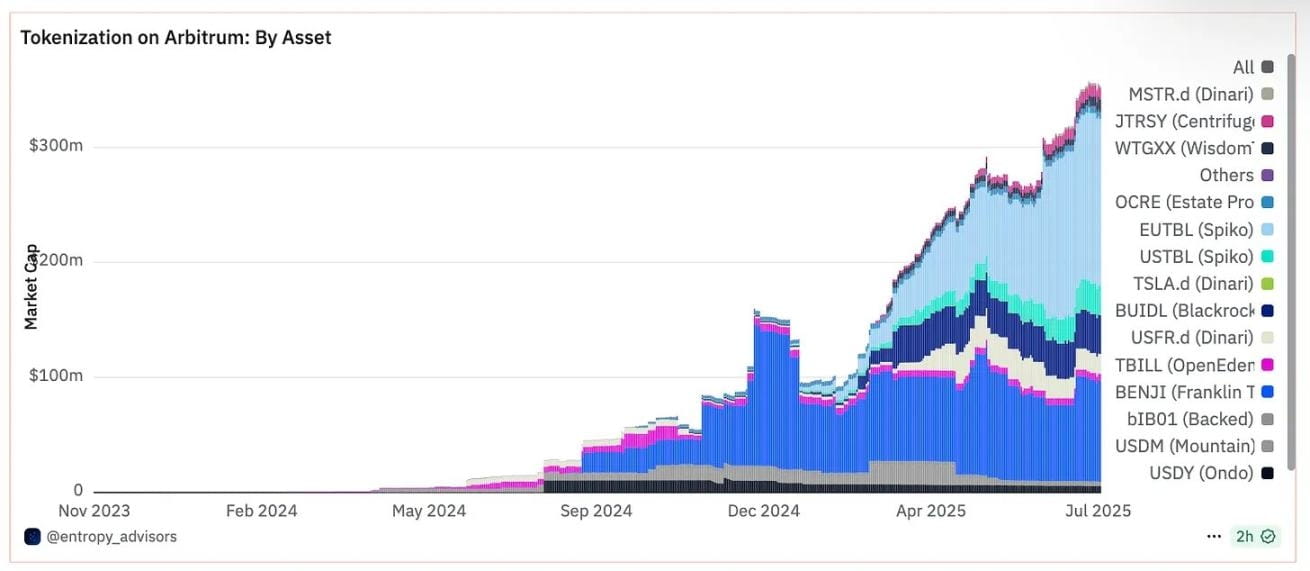
This section will delve into these asset classes, highlighting the top ten RWA products ranked by total value and categorizing them by issuer.

Spiko
Spiko has created an on-chain securities token issuance and distribution platform.
The platform has received permission from the French Financial Markets Authority (AMF) to launch two money market funds:
Spiko Euro (EUTBL)
Spiko Dollar (USTBL)
These funds are backed by short-term government bond portfolios, with yields close to central bank risk-free rates. Currently, they are among the most widely used products, with EUTBL ranking first at a total value of $146 million and USTBL fourth at $24.8 million, once again proving that short-term government bonds are the most widely applied assets on-chain.
Franklin Templeton
Franklin Templeton is a well-known investment management company listed on the New York Stock Exchange (BEN).
To bring tokenized mutual funds on-chain, the company launched the BENJI mobile app, whose proprietary record system supports tokenized securities and cryptocurrencies.
Each BENJI token represents a share of the U.S. government money market fund (FOBXX) on the Franklin chain. Currently, BENJI is the second largest RWA product on Arbitrum, valued at over $87 million.
Securitize
Securitize is a platform providing access to tokenized securities for institutional investors.
On Arbitrum, this platform offers BlackRock's U.S. dollar institutional liquidity fund, BUIDL.
This is a tokenized short-term government bond product focusing on providing on-chain dollar returns, with a total value exceeding $33 million.
Dinari
Dinari allows the creation of tokenized stocks, ETFs, indices, etc., known as 'dShares,' which maintain a 1:1 full endorsement relationship with the underlying assets.
Dinari has launched multiple products on Arbitrum:
WisdomTree floating rate government bond fund (USFR.d): Provides a low-cost investment channel for U.S. government floating rate bonds, with a total value exceeding $15 million.
Tokenized MicroStrategy stock (MSTR.d): Valued at $1.8 million.
Tokenized Tesla stock (TSLA.d): Total value of $450,000.
Tokenized S&P 500 index ETF trust (SPY.d): An index composed of S&P 500 component companies, with a size of approximately $141,000.
These assets highlight the potential of stocks and indices, but their proportion in Arbitrum remains low.
OpenEden
OpenEden provides access services for products such as tokenized U.S. securities. The platform has received licenses from the Bermuda Monetary Authority and holds a digital asset operating license, rated 'investment grade' by Moody's.
Currently, the platform is the most significant issuer of tokenized U.S. government bonds in Europe and Asia. OpenEden has specifically launched the TBILL pool, where users can invest in short-term U.S. government bonds.
Currently, the deposits in this capital pool have exceeded $5.8 million.
Ondo
Ondo provides investors with opportunities to access institutional financial products.
On Arbitrum, its USDY product has initially received a good response, currently totaling a value of $5.7 million.
USDY is an income-generating stablecoin backed by U.S. government bonds, with an annual yield of approximately 4.29%.
Despite having a rich product and asset portfolio, the RWA ecosystem is still in its early stages.
Its future development will depend on:
Asset expansion at the chain level to meet broader demands.
Strategically focusing on RWA as an advantageous area for Arbitrum.
Collaboration between Arbitrum Alliance Entities (AAE).
Institutional-driven business development.
Future outlook
The initial providers established by STEP were supplemented by a new batch of providers during STEP 2, enriching the asset and product offerings on Arbitrum.
Based on the current growth rate of the total value of RWA on Arbitrum, we can make the following predictions:
Forming a billion-dollar RWA ecosystem.
Incorporating more asset classes (private credit, real estate, income-generating stablecoins, etc.)
Achieving deeper interoperability of these assets across different networks.
Despite some progress made, Arbitrum still has immense growth potential if it wants to solidify its position in this niche field. In fact, in the network ranking of total value of RWA assets, Arbitrum only ranks seventh; according to current data, its $350 million total locked value (TVL) accounts for only 1.39% of the total market value of on-chain RWA assets, a minuscule proportion.

To compete with these networks, Arbitrum needs to explore more opportunities, expanding into private credit issuance products, bonds, precious metals like gold and silver, as well as stocks.
Given Entropy's deep involvement in treasury management and RWA-related affairs on Arbitrum, we consulted Matt for his views on the future development of RWA on Arbitrum. Here are his insights:
Today, many core concerns of RWA issuers focus on reducing operational costs associated with issuance and transfer, and there is still a long way to go to validate this at scale. Nevertheless, the next major breakthrough for RWA on Arbitrum will be further enhancing composability. This is not just about adding more asset classes or introducing new issuers; that is just the first step. The real breakthrough lies in ensuring that these assets can integrate with the more efficient on-chain foundational components built over the past decade: exchanges, lending protocols, index tools, liquidity pool optimization tools, and various innovations that may emerge in the future. The ultimate goal is to achieve open, permissionless transferability, allowing RWA to be composable like native crypto assets. We have not yet reached this stage (considering the current regulatory realities, this is an ambitious goal), but it is our guiding star. Encouragingly, industry giants like Franklin and WisdomTree have begun to personally issue tokens. This is true institutional participation and a trend I hope to see continue.
We fully agree with Matt's views, especially regarding the composability and accessibility of these assets. Currently, the on-chain application potential of these assets is just beginning to emerge. We look forward to a future where U.S. Treasury bills, bonds, stocks, and commodities can not only be tokenized on-chain but also integrated into the application scenarios of various foundational components currently present in the DeFi space.
From a research methodology perspective, it is necessary to clarify that in this report focusing on RWA, we have not included stablecoins in the analysis scope, as the core aim of the report is to highlight the various assets available on the current Arbitrum platform.
Equally important is the need to mention the related risks and considerations in conjunction with this analysis.
Risk and forward-looking considerations
Disconnection between tokens and ecosystems: The growth of real RWA does not directly translate into an appreciation in the value of ARB tokens.
Asset concentration risk: Short-term government bonds still account for a very high proportion of the total locked value (TVL) in RWA, highlighting the need to diversify allocations into private credit, corporate bonds, real estate, and other asset classes.
Regulatory dynamic risk: Although the regulatory environment for cryptocurrencies is continuously improving and gradually moving towards legalization, the compliance framework for tokenized securities is still in development stages, and institutional issuance demands higher clarity and coordination across jurisdictions.
The expansion of asset issuers, as well as the on-chain expansion of RWA categories like private credit and real estate, is expected to push the total locked value (TVL) of the Arbitrum ecosystem close to $1 billion by the end of the year.
With the comprehensive advancement of the treasury management plan and STEP 2, we expect to gain more information and insights that will not only further reveal the implementation results of the aforementioned plans but also provide references for future decisions and initiatives.
Conclusion
The total locked value (TVL) of RWA on Arbitrum has grown from nearly zero to $350 million in just over a year.
The STEP program and a series of initiatives led by the DAO played a key role in driving early growth. In this process, a diverse range of institutional-grade products has been launched on Arbitrum, such as short-term government bonds, money market funds, and tokenized stocks.
The entry of institutions like Franklin Templeton and WisdomTree further solidifies Arbitrum's core position as a 'reliable, neutral, and low-cost network' in the institutional-grade DeFi space.
But this process has only just begun.
Beyond the aforementioned risks and issues, Arbitrum will face several strategic opportunities in the coming months.
This includes expanding into RWA categories like private credit, real estate, and commodities that have not been fully covered, and more importantly, enhancing the composability of these new products for deep integration with Arbitrum's core foundational components (decentralized exchanges, lending protocols, liquidity pools, etc.).
The collaboration between DAO, alliance entities, and institutional participants, driven by the ongoing STEP 2 and treasury management program, will be key to Arbitrum's long-term leadership in the RWA field.

